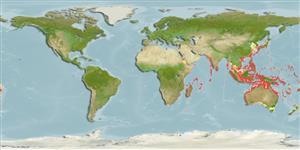Preferred temperature (Fonte Biblio.
123201): 22.4 - 29, mean 27.7 °C (based on 974 cells).
Phylogenetic diversity index (Fonte Biblio.
82804): PD
50 = 1.0000 [Uniqueness, from 0.5 = low to 2.0 = high].
Bayesian length-weight: a=0.00955 (0.00501 - 0.01821), b=3.07 (2.90 - 3.24), in cm total length, based on LWR estimates for this species & (Sub)family-body (Ref.
93245).
Trophic level (Fonte Biblio.
69278): 3.1 ±0.0 se; based on diet studies.
Resilienza (Fonte Biblio.
120179): Alto, tempo minimo di raddoppiamento della popolazione meno di 15 mesi (Preliminary K or Fecundity.).
Fishing Vulnerability (Ref.
59153): Low vulnerability (10 of 100).
🛈
Nutrients (Ref.
124155): Calcium = 38.9 [14.5, 124.6] mg/100g; Iron = 0.757 [0.328, 1.742] mg/100g; Protein = 19.2 [17.0, 21.4] %; Omega3 = 0.227 [0.099, 0.466] g/100g; Selenium = 13.9 [6.2, 32.8] μg/100g; VitaminA = 62.3 [20.9, 191.6] μg/100g; Zinc = 1.04 [0.65, 1.73] mg/100g (wet weight);
